Indesit WISE 127 X User Manual [ru]

Instructions for use
|
|
|
|
|
|
|
WASHING MACHINE |
||
|
|
|
|
|
|
|
|
|
|
|
|
|
|
|
|
|
|
|
|
|
|
|
|
|
|
|
Contents |
|
|
|
|
|
|
|
|
|
GB |
||
|
|
|
|
|
|
|
|
|
|
|
|
|
|
|
|
|
Installation, 2-3 |
|
|
|
GB |
|
SL |
|
CZ |
|
|
||
|
|
|
|
Unpacking and levelling, 2 |
|||||
|
|
|
|
|
|
|
Electric and water connections, 2-3 |
||
|
English,1 |
Slovenšèina,13 |
Èeský,25 |
||||||
|
The first wash cycle, 3 |
||||||||
|
|
|
|
|
|
|
Technical details, 3 |
||
RO HU
Românã,37 Magyar,49
WISE 127 X
Washing machine description, 4-5
Control panel, 4 Display, 5
“MEMO” Programme, 5
Starting and Programmes, 6
Briefly: how to start a programme, 6 Programme table, 6
Personalisations, 7
Setting the spin cycle, 7
Setting the Delay Timer, 7
Setting the temperature, 7
Functions, 7
Detergents and laundry, 8
Detergent dispenser, 8
Bleach cycle, 8
Preparing your laundry, 8
Special items, 8
Precautions and advice, 9
General safety, 9 Disposal, 9
Saving energy and respecting the environment, 9
Care and maintenance, 10
Cutting off the water or electricity supply, 10 Cleaning your appliance, 10
Cleaning the detergent dispenser, 10 Caring for your appliance door and drum, 10 Cleaning the pump, 10
Checking the water inlet hose, 10
Troubleshooting, 11
Service, 12
Before calling for Assistance, 12
1
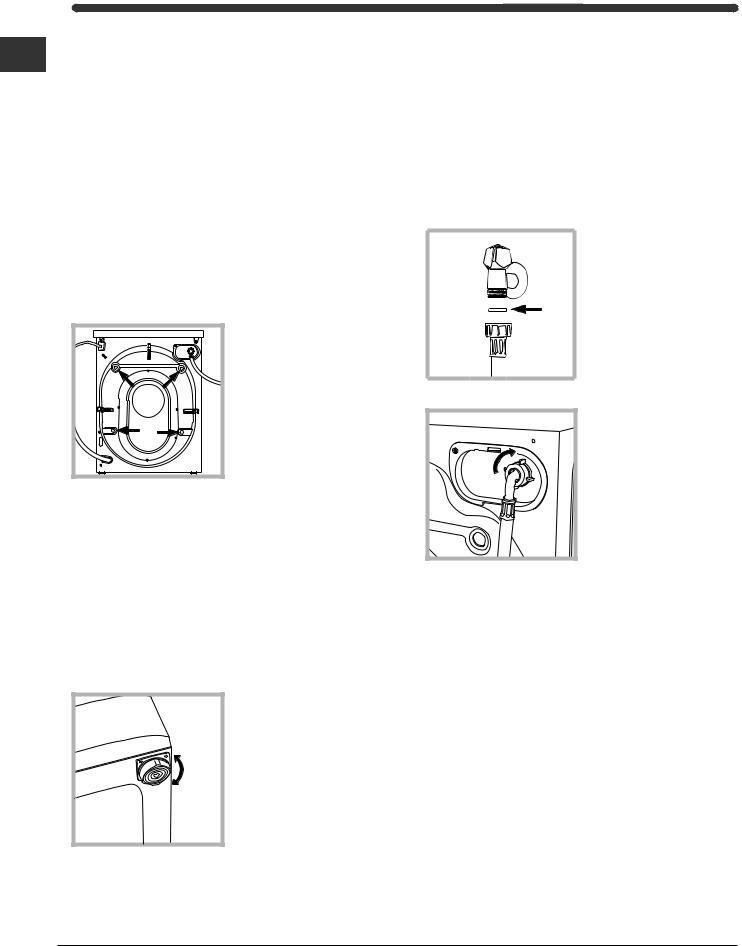
Installation
Keep this instruction manual in a safe place for GB future reference. Should the appliance be sold,
transferred or moved, make sure the instruction manual accompanies the washing machine to inform the new owner as to its operation and features.
Read these instructions carefully: they contain vital information on installation, use and safety.
Unpacking and levelling
Unpacking
1.Unpack the washing machine.
2.Check whether the washing machine has been damaged during transport. If this is the case, do not install it and contact your retailer.
3. Remove the 4 protective screws and the rubber washer with the respective spacer, situated on the rear of the appliance (see figure).
4.Seal the gaps using the plastic plugs provided.
5.Keep all the parts: you will need them again if the washing machine needs to be moved to another location.
Packaging materials are not children's toys.
Levelling
1. Install the washing machine on a flat sturdy floor, without resting it up against walls, furniture cabinets or other.
2. If the floor is not perfectly level, compensate for any unevenness
by tightening or
loosening the adjustable
front feet (see figure); the angle of inclination, measured according to the worktop, must not exceed 2°.
Levelling your appliance correctly will provide it with stability and avoid any vibrations, noise and shifting during operation. If it is placed on a fitted or loose carpet, adjust the feet in such a way as to allow enough room for ventilation beneath the washing machine.
Electric and water connections
Connecting the water inlet hose
1. Insert seal A into the end of the inlet hose and screw the latter onto a cold water tap with a 3/4 gas threaded
A |
mouth (see figure). |
|
|
|
Before making the |
|
connection, allow the |
|
water to run freely until |
|
it is perfectly clear. |
|
2. Connect the other end |
|
of the water inlet hose to |
|
the washing machine, |
|
screwing it onto the |
|
appliance's cold water |
|
inlet, situated on the top |
|
right-hand side on the |
|
rear of the appliance |
|
(see figure). |
3. Make sure there are no kinks or bends in the hose.
The water pressure at the tap must be within the values indicated in the Technical details table
(on the next page).
If the water inlet hose is not long enough, contact a specialist store or an authorised serviceman.
2
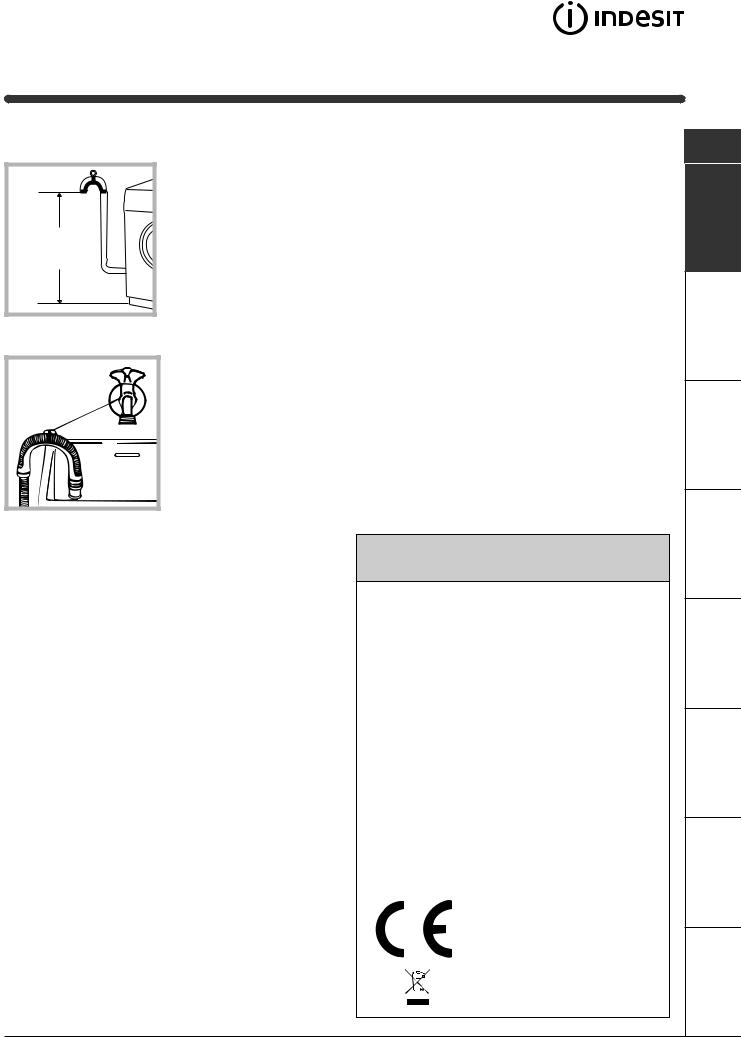
Connecting the drain hose
65 - 100 cm |
Connect the drain hose, without bending it, to a draining duct or a wall drain situated between 65 and 100 cm from the floor;
alternatively, place it over the edge of a basin, sink or tub, fastening the duct supplied to the tap (see figure). The free end of the hose should not be underwater.
We advise against the use of hose extensions; in case of absolute need, the extension must have the same diameter as the original hose and must not exceed 150 cm in length.
Electric connection
Before plugging the appliance into the mains socket, make sure that:
•the socket is earthed and in compliance with the applicable law;
•the socket is able to sustain the appliance's maximum power load indicated in the Technical details table (on the right);
•the supply voltage is included within the values i ndicated on the Technical details table
(on the right);
•the socket is compatible with the washing machine's plug. If this is not the case, replace the socket or the plug.
The washing machine should not be installed in an outdoor environment, not even when the area is sheltered, because it may be very dangerous to leave it exposed to rain and thunderstorms.
When the washing machine is installed, the mains socket must be within easy reach.
Do not use extensions or multiple sockets.
The power supply cable must never be bent or dangerously compressed.
The power supply cable must only be replaced by an authorised serviceman.
Warning! The company denies all liability if and when these norms are not respected.
The first wash cycle
Once the appliance has been installed, and before you use it for the first time, run a wash cycle with detergent and no laundry, setting the 90°C programme without a pre-wash cycle.
Technical details
Model |
WISE 127 X |
|
|
|
|
|
59.5 cm wide |
|
Dimensions |
85 cm high |
|
|
40 cm deep |
|
|
|
|
Capacity |
from 1 to 4,5 kg |
|
|
|
|
Electric |
voltage 220/230 Volts 50 Hz |
|
connections |
maximum absorbed power 1850 W |
|
|
|
|
Water |
maximum pressure 1 MPa (10 bar) |
|
minimum pressure 0.05 MPa (0.5 bar) |
||
connections |
||
drum capacity 40 litres |
||
|
||
|
|
|
Spin speed |
up to 1200 rpm |
|
|
|
|
Control |
|
|
programmes |
programme 2; temperature 60°C; |
|
according to |
run with a load of 4,5 kg. |
|
IEC456 directive |
|
|
|
|
|
|
This appliance is compliant with the |
|
|
following European Community |
|
|
Directives: |
|
|
- 73/23/CEE of 19/02/73 (Low |
|
|
Voltage) and subsequent amendments |
|
|
- 89/336/CEE of 03/05/89 |
|
|
(Electromagnetic Compatibility) and |
|
|
subsequent amendments |
|
|
- 2002/96/CE |
GB
Precautions Detergents Programmes Description Installation
Service Troubleshooting Care
3

Washing machine description
Control panel
GB |
FUNCTION |
|
Buttons |
||
|
START/RESET button
START/STOP button
Display Control knob
Detergent dispenser
|
TEMPERATURE |
|
|
button |
|
SPIN |
DELAY TIMER |
|
button |
||
button |
||
|
Detergent dispenser to add detergent and fabric softener (see page 8).
SPIN button to adjust the spin speed or exclude it altogether (see page 7).
DELAY TIMER button to delay the start of the set programme for a maximum period of 24 hours
(see page 7).
TEMPERATURE button to adjust the wash temperature (see page 7).
Display to programme the washing machine and follow the wash cycle progress (see opposite page).
FUNCTION buttons: to select the functions available. The button corresponding to the function selected will remain on.
START/RESET button to start the programmes or cancel any incorrect settings.
START/STOP button to turn the washing machine on and off.
Control knob to select the wash programmes. The knob stays still during the cycle.
4
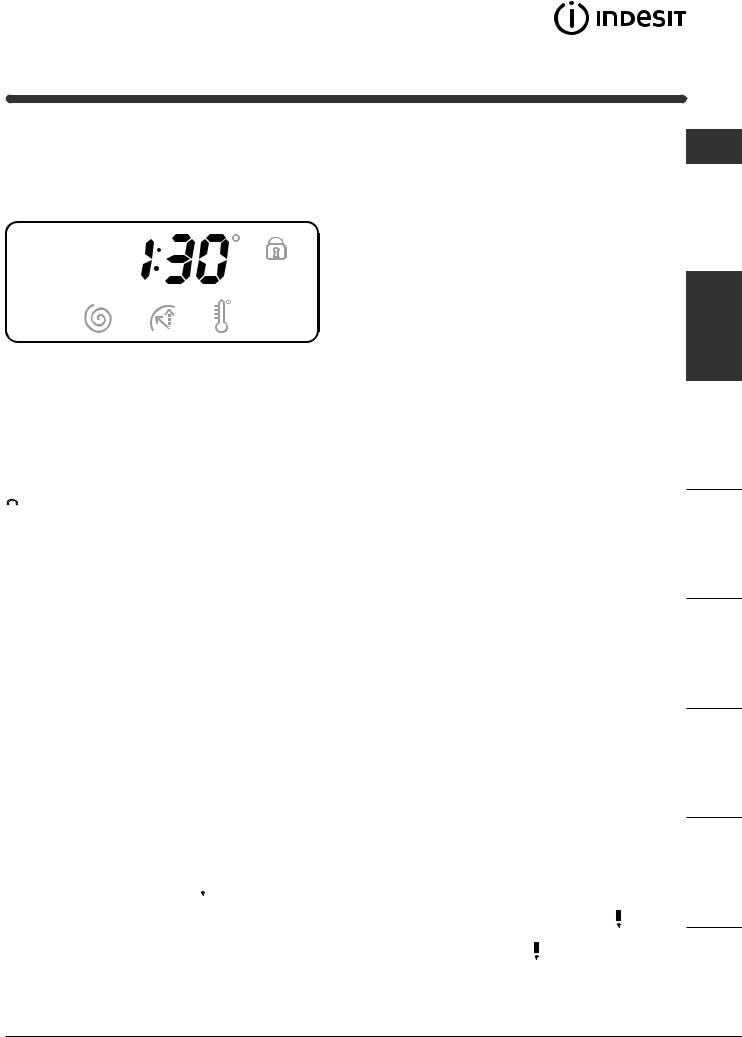
Display
In addition to being a practical tool to programme your appliance (see page 7), the display provides useful information concerning the wash cycle.
Once you have pressed the START/RESET button to start the programme, the display will indicate the amount of time left until the end of the wash cycle. If a delayed start has been set (using the Delay Timer, see page 7), the delay time will be indicated on the display.
 Door lock:
Door lock:
If the symbol is on, the washing machine door is locked to prevent it from being opened accidentally. To avoid any damages, wait for the symbol to switch itself off before you open the appliance door.
At the end of the programme, the word END is displayed.
In the event of an anomaly, an error code will appear, such as: F-01, which should be communicated to the Service Centre (see page 12).
"MEMO" Programme 
This programme allows you to store your favourite or most-used wash cycle.
All you have to do is set the desired programme and, once it has started, turn the KNOB to position  ; the wash cycle will be stored automatically and the word MEMO appears on the display, flashing for a few seconds. Subsequently, you can start the "MEMO" cycle by simply turning the KNOB to position
; the wash cycle will be stored automatically and the word MEMO appears on the display, flashing for a few seconds. Subsequently, you can start the "MEMO" cycle by simply turning the KNOB to position  ; you will be able to see the temperature/spin cycle/delay timer values by pressing the corresponding buttons; you will also be able to modify them but this variation will only be valid for the programme in progress and it will not be stored in the "MEMO" cycle.
; you will be able to see the temperature/spin cycle/delay timer values by pressing the corresponding buttons; you will also be able to modify them but this variation will only be valid for the programme in progress and it will not be stored in the "MEMO" cycle.
If you want to store a new wash cycle, repeat the above-mentioned operations.
GB
Service Troubleshooting Care Precautions Detergents Programmes Description Installation
5

Starting and Programmes
Briefly: starting a programme
GB |
1. Turn the washing machine on by pressing button |
. |
|
2.Load your laundry into the washing machine and shut the appliance door.
3.Set the knob to the desired programme. The estimated duration of the selected programme is displayed. The temperature and spin speed are automatically set according to the programme (to change them, see page 7).
4.Select any functions (see page 7).
5.Add the detergent and any fabric softener
(see page 8).
6.Start he programme by pressing the START/RESET button.
To cancel it, keep the START/RESET button pressed for at least 2 seconds.
7.When the programme has ended, the word END is displayed. Take out your laundry and leave the appliance door ajar to allow the drum to dry thoroughly.
8.Turn the washing machine off by pressing button  .
.
Programme table
Type of fabric and |
Programmes |
Tempe- |
D etergent |
Fabric |
Stain removal |
C ycle |
D escription of wash cycle |
|
degree of soil |
rature |
|
|
softener |
option/bleach |
length |
||
|
pre- |
w ash |
(minutes) |
|
||||
|
|
|
w ash |
|
|
|
|
|
|
|
|
|
|
|
|
|
|
Standard |
|
|
|
|
|
|
|
|
Extremely soiled whites |
1 |
90°C |
• |
• |
• |
|
135 |
Pre-wash, wash cycle, rinse cycles, |
(sheets, tablecloths, etc.) |
|
intermediate and final spin cycles |
||||||
|
|
|
|
|
|
|
||
Extremely soiled whites |
2 |
90°C |
|
• |
• |
Delicate/ |
125 |
Wash cycle, rinse cycles, |
(sheets, tablecloths, etc.) |
|
Traditional |
intermediate and final spin cycles |
|||||
|
|
|
|
|
|
|||
Heavily soiled whites and fast |
2 |
60°C |
|
• |
• |
Delicate/ |
110 |
Wash cycle, rinse cycles, |
colours |
|
Traditional |
intermediate and final spin cycles |
|||||
|
|
|
|
|
|
|||
Heavily soiled whites and |
2 |
40°C |
|
• |
• |
Delicate/ |
105 |
Wash cycle, rinse cycles, |
delicate colours |
|
Traditional |
intermediate and final spin cycles |
|||||
|
|
|
|
|
|
|||
Slightly soiled w hites and |
|
|
|
|
|
Delicate/ |
|
Wash cycle, rinse cycles, |
delicate colours (shirts, |
3 |
40°C |
|
• |
• |
70 |
||
|
Traditional |
intermediate and final spin cycles |
||||||
jumpers, etc.) |
|
|
|
|
|
|
||
|
|
|
|
|
|
|
|
|
Heavily soiled fast colours |
4 |
60°C |
|
• |
• |
Delicate |
75 |
Wash cycle, rinse cycles, anti- |
(baby linen, etc.) |
|
crease or delicate spin cycle |
||||||
|
|
|
|
|
|
|
||
Heavily soiled fast colours |
4 |
40°C |
|
• |
• |
Delicate |
60 |
Wash cycle, rinse cycles, anti- |
(baby linen, etc.) |
|
crease or delicate spin cycle |
||||||
|
|
|
|
|
|
|
||
W ool |
5 |
40°C |
|
• |
• |
|
50 |
Wash cycle, rinse cycles, anti- |
|
|
crease and delicate spin cycle |
||||||
|
|
|
|
|
|
|
|
|
Very delicate fabrics |
6 |
30°C |
|
• |
• |
|
45 |
Wash cycle, rinse cycles, anti- |
(curtains, silk, viscose, etc.) |
|
|
crease or draining cycle |
|||||
|
|
|
|
|
|
|
||
Tim e 4 you |
|
|
|
|
|
|
|
|
Heavily soiled whites and fast |
7 |
60°C |
|
• |
• |
|
60 |
Wash cycle, rinse cycles, |
colours |
|
|
intermediate and final spin cycles |
|||||
|
|
|
|
|
|
|
||
|
|
|
|
|
|
|
|
|
Slightly soiled w hites and |
|
|
|
|
|
|
|
Wash cycle, rinse cycles, |
delicate colours (shirts, |
8 |
40°C |
|
• |
• |
|
50 |
|
|
|
intermediate and final spin cycles |
||||||
jumpers, etc.) |
|
|
|
|
|
|
|
|
|
|
|
|
|
|
|
|
|
Delicate colours (all types of |
9 |
40°C |
|
• |
• |
|
40 |
Wash cycle, rinse cycles, |
slightly soiled garments) |
|
|
delicate spin cycle |
|||||
|
|
|
|
|
|
|
||
|
|
|
|
|
|
|
|
|
Delicate colours (all types of |
10 |
30°C |
|
• |
• |
|
30 |
Wash cycle, rinse cycles and |
slightly soiled garments) |
|
|
delicate spin cycle |
|||||
|
|
|
|
|
|
|
||
|
|
|
|
|
|
|
|
|
Sport |
|
|
|
|
|
|
|
|
|
|
|
|
|
|
|
|
Cold wash (without detergents), |
Sports shoes (MAX. 2 pairs) |
11 |
30°C |
|
• |
• |
|
50 |
wash cycle, rinse cycles, and |
|
|
|
|
|
|
|
|
delicate spin cycle |
Fabrics for sportswear |
12 |
30°C |
|
• |
• |
|
60 |
Wash cycle, rinse cycles, |
(Tracksuits, shorts, etc.) |
|
|
intermediate and final spin cycles |
|||||
|
|
|
|
|
|
|
||
M EM O |
|
Allow s for any w ash cycle to be stored (see page 5). |
|
|||||
|
|
|
|
|
|
|
|
|
PAR TIAL PR OGR AMM ES |
|
|
|
|
|
|
|
|
Rinse |
|
|
|
|
• |
Delicate/ |
|
Rinse cycles and spin cycle |
|
|
|
|
Traditional |
|
|||
|
|
|
|
|
|
|
|
|
Spin |
|
|
|
|
|
|
|
Draining and spin cycle |
|
|
|
|
|
|
|
|
|
Drain |
|
|
|
|
|
|
|
Draining |
|
|
|
|
|
|
|
|
|
Notes
-For programmes 7 and 8, we advise against exceeding a wash load of 3.5 kg. -For programme 12 we advise against exceeding a wash load of 2 kg.
-For the anti-crease function: see Easy iron, opposite page. The information contained in the table is purely indicative.
Special programme
Daily (programme 10 for Synthetics) is designed to wash lightly soiled garments in a short amount of time: it only lasts 30 minutes and allows you to save on both time and energy. By setting this programme (10 at 30°C), you can wash different fabrics together (except for woollen and silk items), with a maximum load of 3 kg.
We recommend the use of liquid detergent.
6
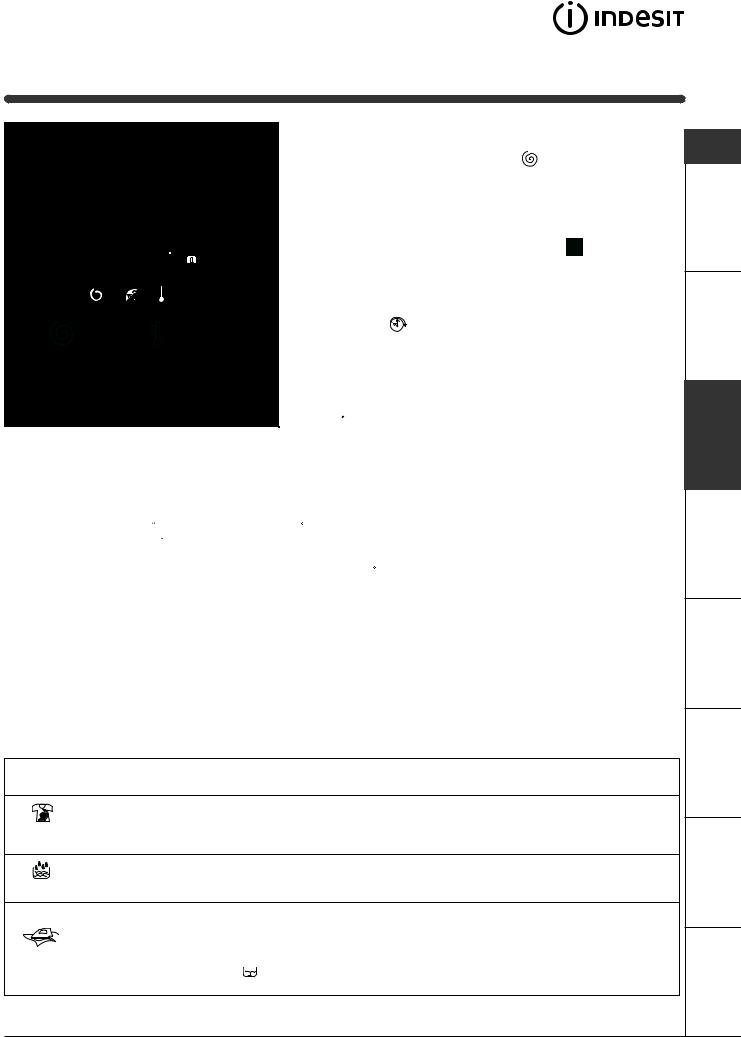
Personalisations
Setting the spin cycle
FUNCTION buttons |
If, when the appliance is switched on, the KNOB is positioned on |
|||||
|
||||||
|
a programme with a spin cycle, a fixed |
appears. Press button |
||||
|
|
and the maximum spin speed allowed for the programme set |
||||
|
|
be displayed, and the |
|
icon flashes. Press it again and the |
||
|
will |
|||||
|
values lower until they reach |
OFF, which indicates that the spin |
||||
|
cycle has been excluded (press it again to go back to the |
|||||
|
maximum value); stop on the desired speed, after approximately |
|||||
|
2 seconds the setting is accepted: the symbol |
remains fixed. |
||||
The spin cycle setting is enabled with all the programmes except for 6 and the Draining cycle.
Setting the Delay Timer
Press the button |
and you will see the word OFF on the |
display, while the relative symbol flashes. |
|
Press the button again and "1h" appears, that is, a delay of one hour (this can reach up to 24h); stop on the "desired" delay; after approximately 2 seconds the setting is accepted, following which, the time for the set programme appears on the display and the symbol  remains on.
remains on.
If you now press the START/RESET button, the set "delay" appears; this decreases every hour until the start of the cycle. In
this phase, the "delay" can only be modified by decreasing it. The Delay Timer regulation is enabled with all programmes.
GB
Programmes Description Installation
Setting the temperature
If, when the appliance is switched on, the KNOB is positioned on a programme for which the temperature needs to be regulated, a fixed  appears. Press button
appears. Press button  and the maximum temperature allowed for the programme set will be displayed and the
and the maximum temperature allowed for the programme set will be displayed and the  icon flashes. Press it again and the temperature lowers until it reaches OFF, which indicates a cold wash cycle (press it again to go back to the maximum value); stop on the desired value, after approximately 2 seconds the setting is accepted: the symbol
icon flashes. Press it again and the temperature lowers until it reaches OFF, which indicates a cold wash cycle (press it again to go back to the maximum value); stop on the desired value, after approximately 2 seconds the setting is accepted: the symbol  remains fixed.
remains fixed.
The temperature adjustment is enabled with all wash programmes.
Functions
To enable a function:
1.press the button corresponding to the desired function, according to the table below;
2.the function is enabled when the corresponding button is illuminated.
Note: The rapid flashing of the button indicates that the corresponding function cannot be selected for the programme set.
If you set a function that is incompatible with another function you selected previously, only the last one selected will be enabled.
Function |
Effect |
Comments |
|
Enabled with |
|
|
programmes: |
||||
|
|
|
|
||
|
Bleaching cycle |
Please remember to pour the bleach into extra compartment 4 |
2, 3, 4, |
||
|
designed to |
||||
|
(see page 8). |
||||
Stain |
remove the |
Rinse cycle. |
|||
This function is incompatible with the EASY IRON function. |
|||||
removal |
toughest stains. |
|
|||
|
|
|
|||
|
Increases the |
Recommended when the appliance has a full load or with large |
1, 2, 3, 4, 7, |
||
|
efficiency of the |
8, 9, 11, 12, |
|||
|
quantities of detergent. |
||||
Extra Rinse |
rinse. |
Rinse cycle. |
|||
|
|
||||
|
This option |
When this function is set, programmes 4, 5, 6 will end, with the |
|
||
|
reduces the |
laundry left to soak (Anti-crease), and the relative button flashes: |
3, 4, 5, 6, 7, 8, |
||
|
amount of |
- to conclude the cycle, press the START/RESET button or the |
|||
|
creasing on |
EASY IRON button; |
9, Rinse |
||
|
fabrics, making |
- to run the draining cycle alone, set the knob to the relative |
cycle. |
||
|
them easier to |
symbol |
and press the START/RESET button. |
|
|
Easy iron |
iron. |
This function is incompatible with the STAIN REMOVAL function. |
|
||
|
|
|
|
|
|
Precautions Detergents
Service Troubleshooting Care
7
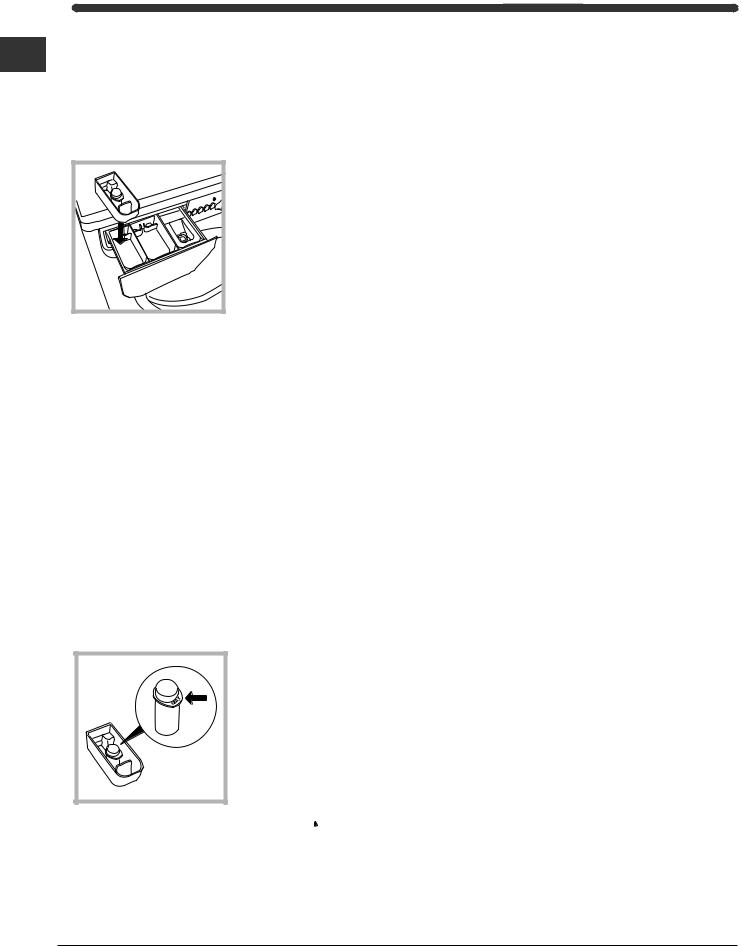
Detergents and laundry
Detergent dispenser
GB
Good washing results also depend on the correct dose of detergent: adding too much detergent won't necessarily make for a more efficient wash, and may in fact cause build up on the interior of your appliance and even pollute the environment.
4 |
|
|
3 |
1 |
2 |
Open up the detergent dispenser and pour in the detergent and fabric softener, as follows.
compartment 1: Detergent for pre-wash (powder)
Before pouring in the detergent, make sure that extra compartment 4 has been removed. compartment 2: Detergent for the wash cycle (powder or liquid)
Liquid detergent should only be poured in immediately prior to the wash cycle start. compartment 3: Additives (fabric softeners, etc.)
The fabric softener should not overflow from the grid. extra compartment 4: Bleach
Do not use hand wash detergent because it may form too much foam.
Bleach cycle
Traditional bleach should be used on sturdy white fabrics, and delicate bleach for coloured fabrics, synthetics and for wool.
Place extra compartment 4, provided, into compartment 1. When pouring in the
bleach, be careful not to exceed the "max" level indicated on the central pivot (see figure).
To run the bleach cycle alone, pour the bleach into extra compartment 4, set the Rinse programme  and enable the Stain removal function (see page 7).
and enable the Stain removal function (see page 7).
To bleach during a wash cycle, pour in the detergent and fabric softener, set the desired programme and enable the Stain removal function (see page 7).
The use of extra compartment 4 excludes the possibility of using the pre-wash cycle.
Preparing your laundry
•Divide your laundry according to:
-the type of fabric/the symbol on the label.
-the colours: separate coloured garments from whites.
•Empty all pockets and check for loose buttons.
•Do not exceed the weight limits stated below, which refer to the weight when dry:
Sturdy fabrics: max 4,5 kg Synthetic fabrics: max 2.5 kg Delicate fabrics: max 2 kg Wool: max 1 kg
How much does your laundry weigh?
1sheet 400-500 g
1pillow case 150-200 g
1tablecloth 400-500 g
1bathrobe 900-1,200 g
1towel 150-250 g
Special items
Curtains: fold curtains and place them in a pillow case or mesh bag. Wash them separately without exceeding half the appliance load. Use programme 6 which excludes the spin cycle automatically.
Quilted coats and windbreakers: if they are padded with goose or duck down, they can be machine-washed. Turn the garments inside out and load a maximum of 2-3 kg, repeating the rinse cycle once or twice and using the delicate spin cycle. Wool: for best results, use a specific detergent, taking care not to exceed a load of 1 kg.
8
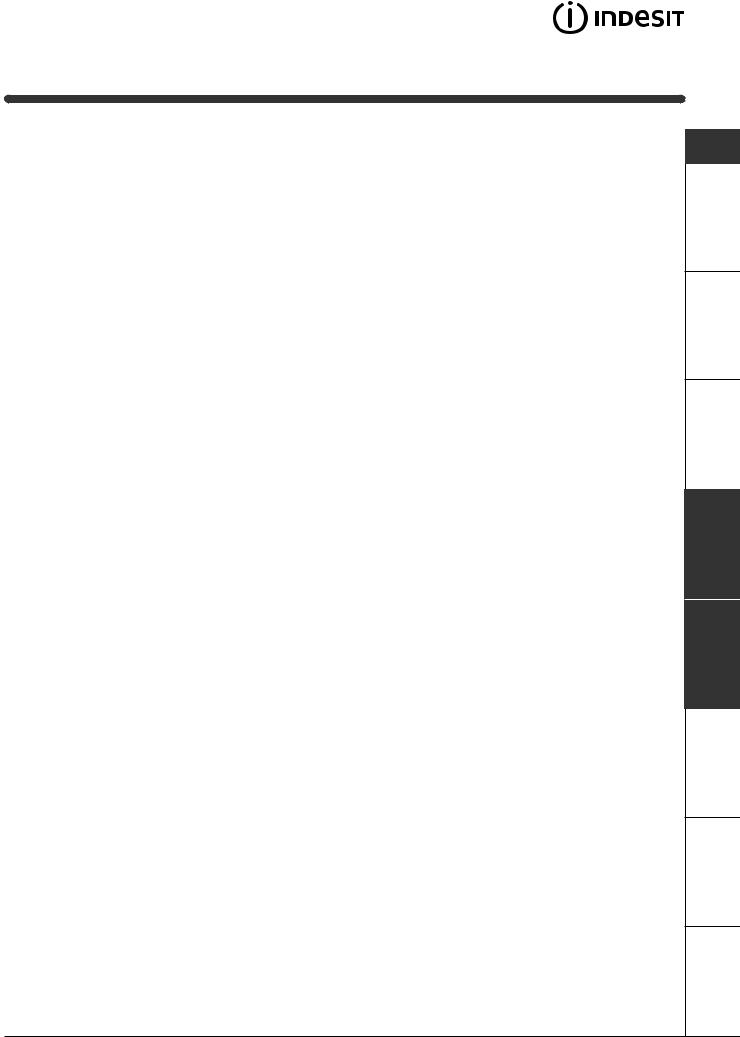
Precautions and advice
The washing machine was designed and built in compliance with the applicable international safety regulations. The following information is provided for your safety and should consequently be read carefully.
General safety
•This appliance has been designed for nonprofessional, household use and its functions must not be changed.
•This washing machine should only be used by adults and in accordance with the instructions provided in this manual.
•Never touch the washing machine when barefoot or with wet or damp hands or feet.
•Do not pull on the power supply cable to unplug the appliance from the electricity socket. Pull the plug out yourself.
•Do not open the detergent dispenser while the appliance is in operation.
•Do not touch the drain water as it could reach very high temperatures.
•Never force the washing machine door: this could damage the safety lock mechanism designed to prevent any accidental openings.
•In the event of a malfunction, do not under any circumstances touch internal parts in order to attempt repairs.
•Always keep children well away from the appliance while in operation.
•The appliance door tends to get quite hot during the wash cycle.
•Should it have to be moved, proceed with the help of two or three people and handle it with the utmost care. Never try to do this alone, because the appliance is very heavy.
•Before loading your laundry into the washing machine, make sure the drum is empty.
Disposal
•Disposing of the packaging material:
observe local regulations, so the packaging can be re-used.
•The European Directive 2002/96/EC on Waste Electrical and Electronic Equipment, requires that old household electrical appliances must not be disposed of in the normal unsorted municipal waste stream. Old appliances must be collected separately in order to optimise the recovery and recycling of the materials they contain and reduce the impact on human health and the environment.
The crossed out "wheeled bin" symbol on the product reminds you of your obligation, that when you dispose of the appliance it must be separately collected.
Consumers should contact their local authority or retailer for information concerning the correct disposal of their old appliance.
Saving energy and respecting the environment
Environmentally-friendly technology
If you only see a little water through your appliance door, this is because thanks to the latest Indesit technology, your washing machine only needs less than half the amount of water to get the best results: an objective reached to respect the environment.
Saving on detergent, water, energy and time
•To avoid wasting resources, the washing machine should be used with a full load. A full load instead of two half loads allows you to save up to 50% on energy.
•The pre-wash cycle is only necessary on extremely soiled garments. Avoiding it will save on detergent, time, water and between 5 and 15% energy.
•Treating stains with a stain remover or leaving them to soak before washing will cut down the need to wash them at high temperatures. A programme at 60°C instead of 90°C or one at 40°C instead of 60°C will save up to 50% on energy.
•Use the correct quantity of detergent depending on the water hardness, how soiled the garments are and the amount of laundry you have, to avoid wastage and to protect the environment: despite being biodegradable, detergents do contain ingredients that alter the natural balance of the environment. In addition, avoid using fabric softener as much as possible.
•If you use your washing machine from late in the afternoon until the early hours of the morning, you will help reduce the electricity board's peak load. The Delay Timer option (see page 7) helps to organise your wash cycles accordingly.
•If your laundry has to be dried in a tumble dryer, select a high spin speed. Having the least water possible in your laundry will save you time and energy in the drying process.
GB
Precautions Detergents Programmes Description Installation
Service Troubleshooting Care
9
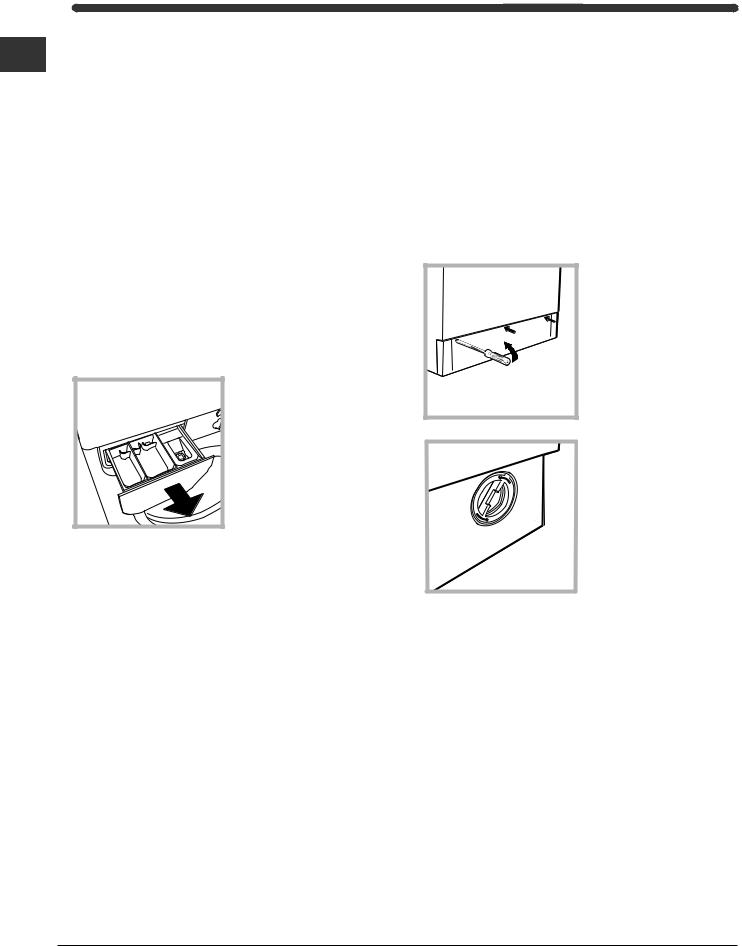
Care and maintenance
Cutting off the water or electricity GB supply
•Turn off the water tap after every wash. This will limit the wear of your appliance's water system and also prevent leaks.
•Unplug your appliance when cleaning it and during all maintenance operations.
Cleaning your appliance
The exterior and rubber parts of your appliance can be cleaned with a soft cloth soaked in lukewarm soapy water. Do not use solvents or abrasives.
Cleaning the detergent dispenser
Remove the dispenser by pulling it out (see figure).
Wash it under running water; this operation should be repeated frequently.
Caring for your appliance door and drum
•Always leave the appliance door ajar to prevent unpleasant odours from forming.
Cleaning the pump
The washing machine is fitted with a self-cleaning pump that does not require any maintenance. Sometimes, small items (such as coins or buttons) may fall into the pre-chamber that protects the pump, situated in the lower part of the same.
Make sure the wash cycle has ended and unplug the appliance.
To access the pre-chamber:
1. using a screwdriver, remove the cover panel on the lower front of the washing machine (see figure);
2. unscrew the lid rotating it anticlockwise (see figure): a little water may trickle out. This is perfectly normal;
3.clean the interior thoroughly;
4.screw the lid back on;
5.reposition the panel, making sure the hooks are securely in place before you push it onto the appliance.
Checking the water inlet hose
Check the water inlet hose at least once a year. If you see any cracks, replace it immediately: during the wash cycles, water pressure is very strong and a cracked hose could easily split open.
Never use hoses that have already been used.
10
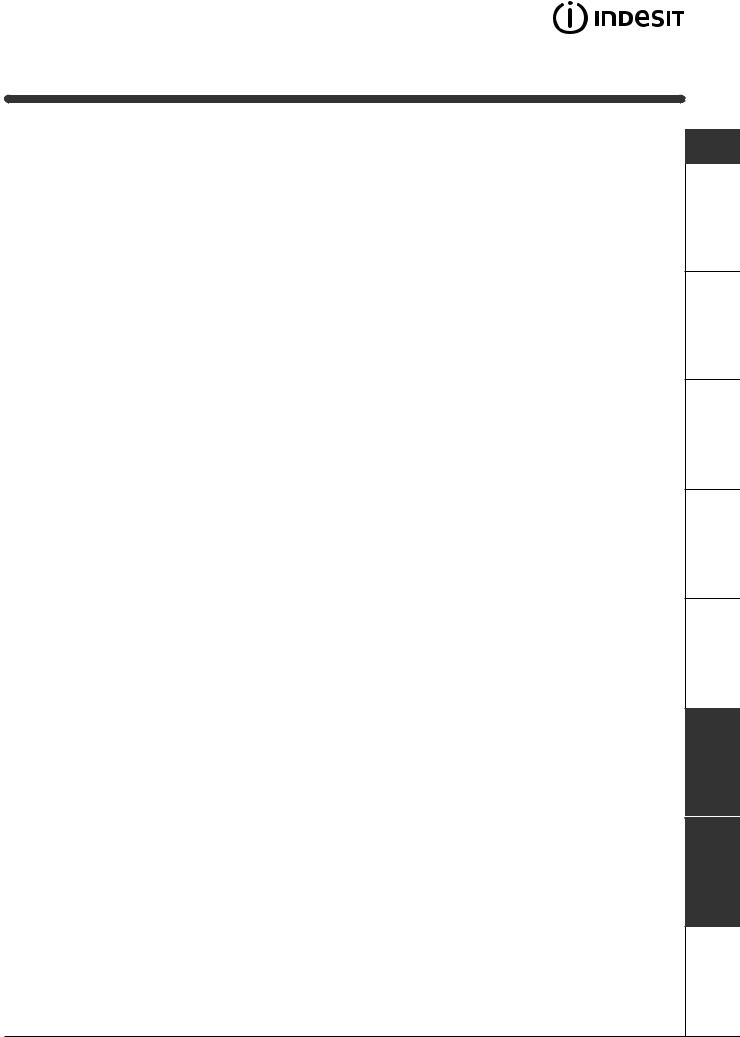
Troubleshooting
Your washing machine could fail to work. Before calling for Assistance (see page 12), make sure the problem can't easily be solved by consulting the following list.
Problem
The washing machine won't start.
The wash cycle won't start.
The washing machine fails to load water (The wording H2O is displayed).
The washing machine continuously loads and unloads water.
The washing machine does not drain or spin.
The washing machine vibrates too much during the spin cycle.
The washing machine leaks.
There is too much foam.
Possible causes/Solution:
•The appliance is not plugged into the socket, or not enough to make contact.
•There has been a power failure.
•The appliance door is not shut properly (the word DOOR is
displayed).
• The  button has not been pressed.
button has not been pressed.
•The START/RESET button has not been pressed.
•The water tap is not turned on.
•A delayed start has been set (using the Delay Timer, see page 7).
•The water inlet hose is not connected to the tap.
•The hose is bent.
•The water tap is not turned on.
•There is a water shortage.
•The water pressure is insufficient.
•The START/RESET button has not been pressed.
•The drain hose is not fitted between 65 and 100 cm from the floor
(see page 3).
•The free end of the hose is underwater (see page 3).
•The wall drainage system doesn't have a breather pipe.
If the problem persists even after these checks, turn off the water tap, switch the appliance off and call for Assistance. If the dwelling is on one of the upper floors of a building, there may be drain trap problems causing the washing machine to load and unload water continuously. In order to avoid such an inconvenience, special anti-drain trap valves are available in shops.
•The programme does not foresee the draining: some programmes require enabling the draining manually (see page 6).
•The Easy iron option is enabled: to complete the programme, press the START/RESET button (see page 7).
•The drain hose is bent (see page 3).
•The drain duct is clogged.
•The drum was not unblocked correctly during installation (see page 2).
•The washing machine is not level (see page 2).
•The washing machine is closed in between furniture cabinets and the wall (see page 2).
•The water inlet hose is not screwed on correctly (see page 2).
•The detergent dispenser is obstructed (to clean it, see page 10).
•The drain hose is not secured properly (see page 3).
•The detergent is not suitable for machine washing (it should bear the definition "for washing machines" or "hand and machine wash", or the like).
•You used too much detergent.
GB
Precautions Detergents Programmes Description Installation
Service Troubleshooting Care
11

Service
GB
Service
Before calling for Assistance:
• Check whether you can solve the problem on your own (see page 11);
•Restart the programme to check whether the problem has been solved;
•If this is not the case, contact an authorised Technical Service Centre on the telephone number provided on the guarantee certificate.
Always request the assistance of authorised servicemen.
Notify the operator of:
•the type of problem;
•the appliance model (Mod.);
•the serial number (S/N).
This information can be found on the data plate situated on the rear of the washing machine.
12

Navodila za uporabo
|
|
|
PRALNI STROJ |
||
|
|
|
|
|
|
|
|
|
|
|
|
|
|
|
Vsebina |
|
|
|
|
|
SL |
||
|
|
|
|
|
|
|
|
|
Namestitev, 14-15 |
|
|
|
SL |
|
|
||
|
|
Odstranitev embalaže in izravnavanje, 14 |
|||
|
|
|
Prikljuèitev na vodovodno in elektrièno napeljavo, 14-15 |
||
|
|
|
|||
|
Slovenšèina |
Prvo pranje, 15 |
|||
|
|
|
Tehnièni podatki, 15 |
||
|
|
|
Opis pralnega stroja, 16-17 |
||
|
|
|
Upravljalna plošèa, 16 |
||
|
|
|
Prikazovalnik, 17 |
||
|
|
|
Program “MEMO”, 17 |
||
|
|
|
Zagon in razlièni pralni programi, 18 |
||
|
|
|
Na kratko: kako zagnati program pranja, 18 |
||
|
|
|
Tabela pralnih programov, 18 |
||
WISE 127 X
Posebne nastavitve, 19
Nastavitev centrifuge, 19
Funkcija delay timer, 19
Nastavitev temperature, 19
Funkcije, 19
Pralna sredstva in perilo, 20
Predal za pralna sredstva, 20 Pranje z belilom, 20 Priprava perila, 20
Posebne vrste perila, 20
Opozorila in nasveti, 21
Varnost, 21
Ravnanje z odpadnim materialom, 21 Varèevanje in skrb za okolje, 21
Vzdrževanje in èišèenje, 22
Odklop vodovodne in elektriène napeljave, 22 Èišèenje pralnega stroja, 22
Èišèenje predala za pralna sredstva, 22 Vzdrževanje vratc in bobna, 22 Èišèenje èrpalke, 22
Pregled cevi za dotok vode, 22
Motnje in njihovo odpravljanje, 23
Pomoè, 24
Preden poklièete pooblašèeni servis, 24
13
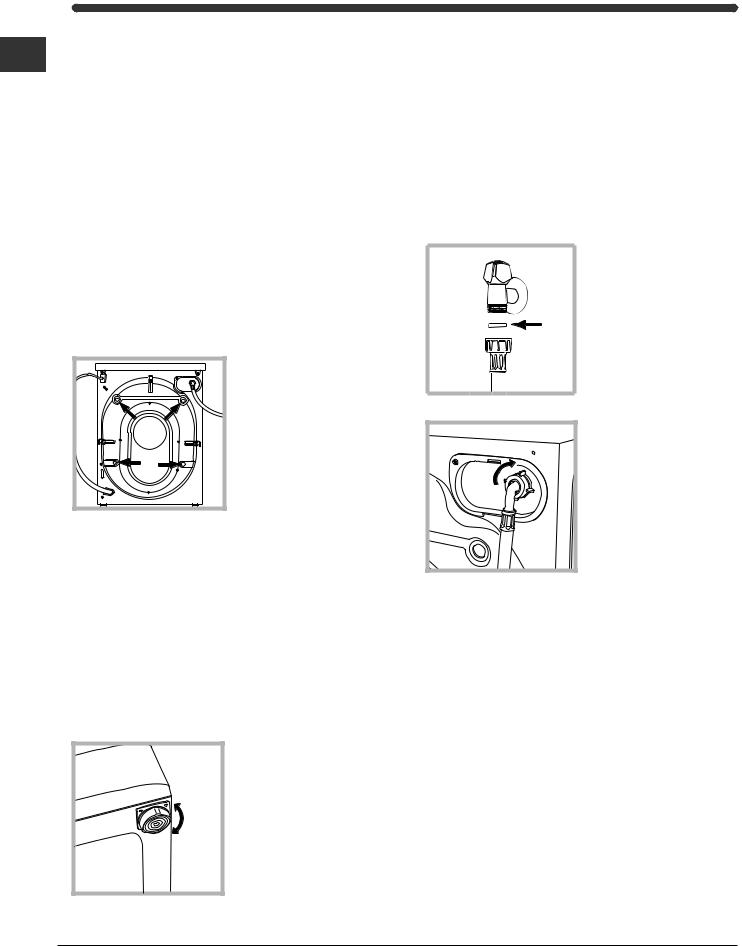
Namestitev
Shranite to knjižico, da jo boste lahko po potrebi SL uporabili. Èe boste pralni stroj prodali, ga nehali
uporabljati ali premestili drugam, naj bo knjižica pri njem, tako da se bo novi lastnik lahko seznanil z delovanjem in ustreznimi opozorili.
Pozorno preberite navodila. Našli boste pomembne informacije glede namestitve, uporabe in zagotavljanja varnosti.
Odstranitev embalaže in izravnavanje
Odstranitev embalaže
1.Odstranite embalažo
2.Preverite, da ni bil pralni stroj med prevozom poškodovan. Èe je poškodovan, ga ne prikljuèite, ampak obvestite prodajalca.
3. Odstranite vse 4 zašèitne vijake in gumico z distanènikom na zadnji strani (glej sliko).
4.S priloženimi plastiènimi èepi zaprite odprtine.
5.Vse odstranjene dele shranite. Èe bo pralni stroj potrebno prevažati, jih bo treba spet namestiti.
Embalaža ni primerna kot igraèa za otroke
Izravnavanje
1. Pralni stroj namestite na ravna in trda tla. Naj se ne dotika sten, pohištva ipd.
2. Èe tla niso popolnoma vodoravna, z odvijanjem ali zavijanjem prednjih nožic uravnajte lego pralnega stroja (glej sliko). Nagib na delovni površini ne sme presegati 2°.
Natanèno izravnanje poveèa stabilnost pralnega stroja in prepreèuje vibracije, hrup in premikanje med delovanjem. Èe je na tleh tapison ali preproga, uravnajte nožice tako, da bo pod pralnim strojem ostalo nekaj prostora za prezraèevanje.
Prikljuèitev na vodovodno in elektrièno napeljavo
Prikljuèitev dotoène cevi za vodo
1. Vstavite tesnilo A na konec dotoène cevi; cev privijte na pipo za dotok hladne vode s ¾” navojem (glej sliko).
A |
Predtem pustite teèi |
|
|
|
vodo, dokler ne bo |
|
èista. |
|
2. Dotoèno cev privijte |
|
na ustrezen prikljuèek |
|
na zadnji strani |
|
pralnega stroja zgoraj |
|
desno (glej sliko). |
3. Pazite, da cev ne bo prepognjena ali stisnjena.
Vodni tlak v pipi mora biti v mejah vrednosti, ki so zapisane v tabeli tehniènih podatkov (glej naslednjo stran).
Èe dotoèna cev ni dovolj dolga, se obrnite na specializirano trgovino ali na pooblašèeni servis.
14
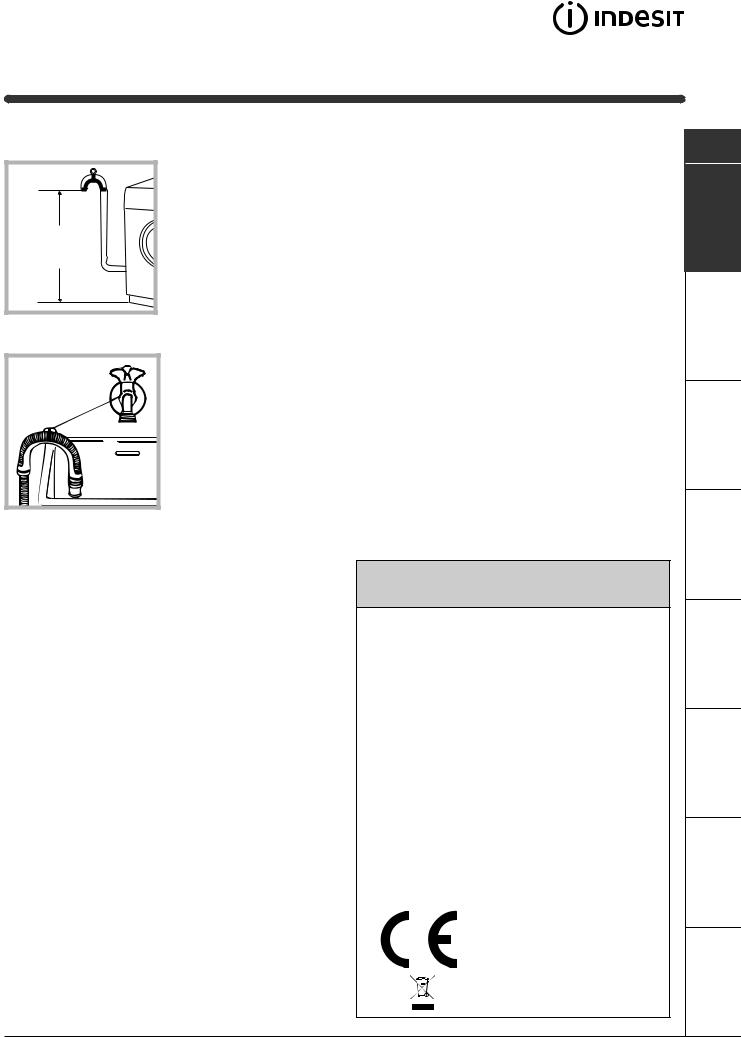
Namestitev odtoène cevi
65 - 100 cm |
Odtoèno cev, ki ne sme biti prepognjena, prikljuèite na odtoèni sistem ali na odtok na zidu, ki sta v višini 65 - 100 cm od tal;
ali jo naslonite na rob umivalnika ali korita; s priloženim vodilom jo pritrdite na pipo (glej sliko). Prosti konec odtoène cevi ne sme biti potopljen v vodo.
Odsvetujemo uporabo podaljška za odtoèno cev. Èe je to nujno, naj ima podaljšek isti premer in naj ne bo daljši od 150 cm.
Prikljuèitev na elektrièno napeljavo
Preden pralni stroj prikljuèite na elektrièno napeljavo, se preprièajte, èe:
•je elektrièni prikljuèek ozemljen in neoporeèen;
•elektrièni prikljuèek zmore najveèjo obremenitev moèi pralnega stroja, ki je zapisana v tabeli tehniènih podatkov (glej poleg);
•elektrièna napetost v vtiènici ustreza vrednostim v tabeli tehniènih podatkov (glej poleg);
•vtiènica ustreza vtikaèu pralnega stroja. V nasprotnem primeru je treba zamenjati vtiènico ali vtikaè.
Pralni stroj ne sme biti namešèen na prostem (èeprav je pod streho), saj ga je zelo nevarno izpostavljati dežju in nevihtam.
Ko je pralni stroj namešèen, naj bo vtiènica lahko dosegljiva.
Ne uporabljajte podaljškov in razdelivcev.
Kabel naj ne bo prepognjen ali stisnjen.
Elektrièni kabel lahko zamenja le pooblašèeni serviser.
Pozor! V primeru neupoštevanja teh navodil naše podjetje ne sprejema nobene odgovornosti.
Prvo pranje
Po prikljuèitvi in pred uporabo zaženite prvo pranje z detergentom in brez perila. Prvo pranje naravnajte na 90°C brez predpranja.
Tehnièni podatki
Model |
WISE 127 X |
|
|
|
|
|
širina 59,5 cm |
|
Dimenzije |
višina 85 cm |
|
|
globina 40 cm |
|
|
|
|
Zmogljivost |
1 - 4,5 kg |
|
|
|
|
Elektrièna napeljava |
napetost 220/230 V, 50 Hz |
|
maksimalna poraba moèi 1850 W |
||
|
||
|
|
|
|
najveèji dovoljeni tlak 1 MPa (10 b) |
|
Vodovodni prikljuèek |
najmanjši dovoljeni tlak 0,05 MPa (0,5 b) |
|
|
prostornina bobna 40 litrov |
|
|
|
|
Hitrost centrifuge |
do 1200 vrtljajev na minuto |
|
|
|
|
Kontrolni program |
program 2; temperatura 60°C; |
|
po standardu IEC456 |
z obremenitvijo 4,5 kg. |
|
|
|
|
|
Pralni stroj je izdelan v skladu z |
|
|
veljavnimi mednarodnimi predpisi: |
|
|
- EEC 73/23 z dne 19.2.1973 (Nizka |
|
|
napetost) s kasnejšimi spremembami |
|
|
- EEC 89/336 z dne 3.5.1989 |
|
|
(Elektromagnetna kompatibilnost) |
|
|
s kasnejšimi spremembami |
|
|
- 2002/96/CE |
SL
Namestitev
Opis
Motnje Vzdrževanje Opozorila sredstva Pralna Programi
Pomoè
15
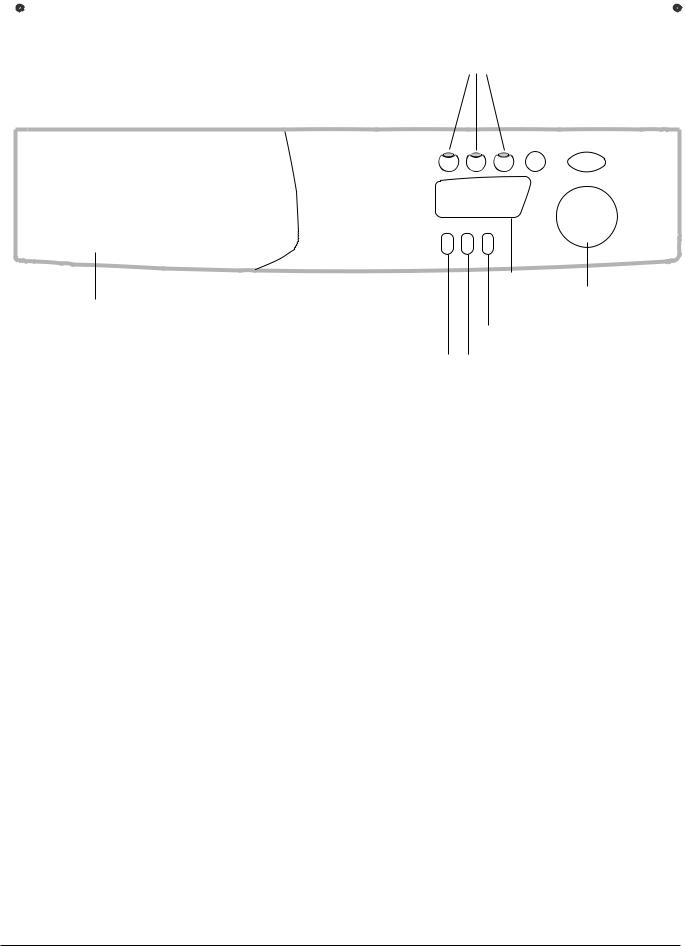
Opis pralnega stroja
|
|
|
|
|
|
|
|
Upravljalna plošèa |
|
Tipka |
|||
|
|
|||||
SL |
|
Tipke |
|
|||
|
|
START/RESET |
||||
|
FUNKCIJ |
|
||||
|
|
|
||||
|
|
|
|
|
Tipka |
|
|
|
|
|
|
||
|
|
|
|
|
VKLOP/IZKLOP |
|
|
|
|
|
|
|
|
Prikazovalnik Gumb
Predal za pralna sredstva
Tipka
TEMPERATURA
Tipka
CENTRIFUGA Tipka
DELAY TIMER
Predal za pralna sredstva za odmerjanje detergentov in dodatkov (glej str. 20).
Tipka CENTRIFUGA za nastavitev hitrosti centrifuge ali njen izklop (glej str. 19).
S tipko DELAY TIMER lahko zakasnimo zaèetek pranja in sicer za najveè 24 ur (glej str. 19).
Tipka TEMPERATURA za nastavitev temperature pranja (glej str. 19).
Prikazovalnik za nastavitev pralnega programa in spremljanje poteka pranja (glej naslednjo stran).
Tipke FUNKCIJ: za nastavitev razpoložljivih funkcij. Tipka za izbrano funkcijo bo ostala prižgana.
Tipka START/RESET za zagon programov ali izbris napaènih nastavitev.
Tipka VKLOP/IZKLOP za vklop in izklop pralnega stroja.
Gumb za izbiranje programov.
Med potekom pranja se gumb ne premika.
16
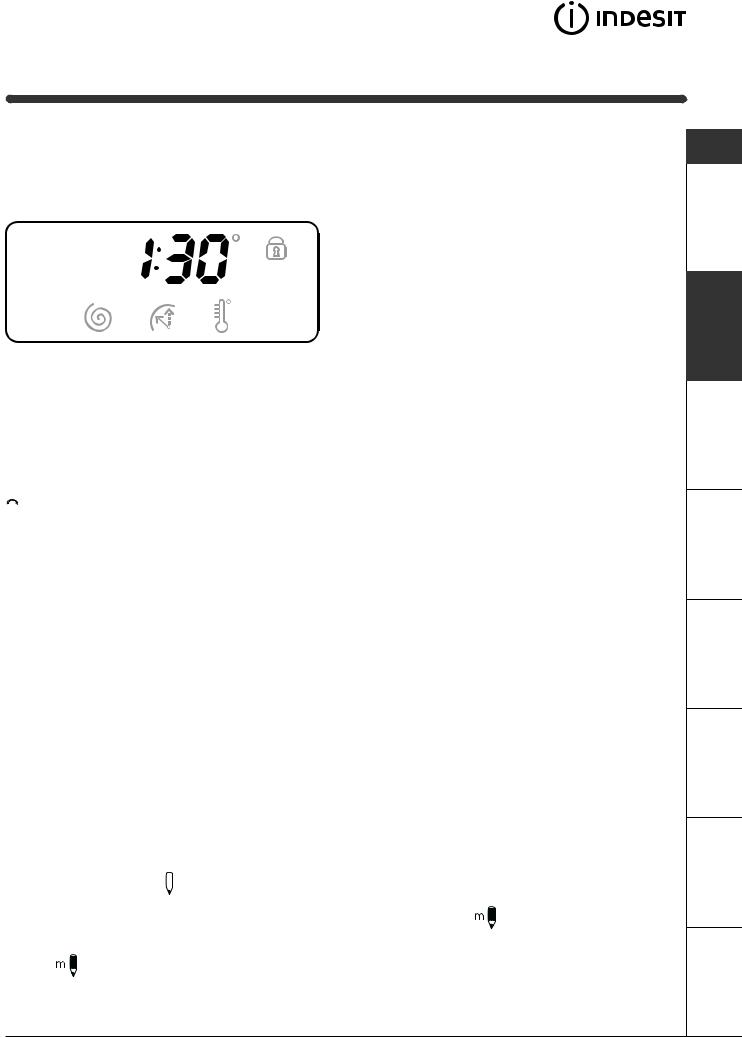
Prikazovalnik
Prikazovalnik služi za programiranje pranja (glej str. 19), poleg tega pa nas tudi sproti obvešèa o poteku pranja.
Ko pritisnemo na tipko START/RESET za zagon pralnega programa, se na prikazovalniku pokaže èas, ki bo potreben do konca pranja. Èe je nastavljena zakasnitev zaèetka pranja, bo to prikazano (“Delay Timer”, glej str. 19)
 Vratca so blokirana:
Vratca so blokirana:
Prižgani znak pomeni: vratca so blokirana, da jih ne bi pomotoma odprli. Preden odprete vratca, morate poèakati, da znak ugasne, sicer lahko pride do poškodb.
Na koncu pranja se pokaže napis END.
Èe pride do nepravilnosti, se pokaže koda napake, na primer F-01. Kodo napake sporoèimo na pooblašèeni servis (glej str. 24).
Program “MEMO” 
S to funkcijo lahko shranimo v spomin pralni program, ki ga najraje ali najpogosteje uporabljamo. Nastavimo željeni program, ga zaženemo in nato zavrtimo GUMB na položaj  . Pralni program se bo samodejno shranil v spomin in na prikazovalniku se bo za nekaj trenutkov pokazal utripajoèi napis “MEMO”. Kasneje lahko ta v spomin shranjeni program “MEMO” zaženemo preprosto tako, da GUMB zavrtimo na
. Pralni program se bo samodejno shranil v spomin in na prikazovalniku se bo za nekaj trenutkov pokazal utripajoèi napis “MEMO”. Kasneje lahko ta v spomin shranjeni program “MEMO” zaženemo preprosto tako, da GUMB zavrtimo na
položaj  ; s pritiskom na ustrezne tipke boste lahko preverili nastavljene vrednosti temperature, centrifuge in zakasnitve zaèetka pranja; te vrednosti boste lahko tudi spremenili, pri tem pa bodo spremembe veljale le za tekoèi pralni program in ne bodo shranjene v spomin (v program “MEMO”).
; s pritiskom na ustrezne tipke boste lahko preverili nastavljene vrednosti temperature, centrifuge in zakasnitve zaèetka pranja; te vrednosti boste lahko tudi spremenili, pri tem pa bodo spremembe veljale le za tekoèi pralni program in ne bodo shranjene v spomin (v program “MEMO”).
Èe želite v spomin shraniti drug pralni program, ponovite zgoraj opisani potek.
SL
Namestitev
Opis
Motnje Vzdrževanje Opozorila sredstva Pralna Programi
Pomoè
17

Zagon in razlièni pralni programi
Na kratko: kako zagnati program pranja
SL |
1. Prižgite pralni stroj s pritiskom na tipko |
. |
|
2.Perilo dajte v pralni stroj in zaprite vratca.
3.Z gumbom nastavite željeni program. Na prikazovalniku se bo pokazal predvideni èas pranja. Temperatura in hitrost centrifuge se samodejno naravnata glede na izbrani program (za spremembo nastavitve glej str. 19).
Tabela pralnih programov
4.Izberite funkcije po želji (glej str. 19).
5.Vstavite detergent in dodatke (glej str. 20).
6.Poženite program s pritiskom na tipko START/ RESET.
Za preklic držite tipko START/RESET najmanj 2 sekundi.
7.Ob zakljuèku programa se pokaže napis END. Perilo vzemite ven, vratca pa pustite priprta, da se boben osuši.
8.Ugasnite pralni stroj s pritiskom na tipko  .
.
Lastnosti tkanine in stopnja |
Program |
Tempe- |
Detergent |
Mehèalec |
Uporaba |
Trajanje |
|
|
|
|
programa |
Potek programa |
|||||
umazanosti |
|
ratura |
|
|
|
belila |
|
|
|
predp- |
pranje |
|
(v minutah) |
|
|||
|
|
|
ranje |
|
|
|
|
|
|
|
|
|
|
|
|
|
|
Standardno perilo |
|
|
|
|
|
|
|
|
Belo perilo, zelo moèno umazano |
1 |
90°C |
• |
• |
• |
|
135 |
Predpranje, pranje, izpiranje, |
(rjuhe, prti ipd.) |
|
vmesno in konèno o¡zemanje |
||||||
|
|
|
|
|
|
|
||
|
|
|
|
|
|
|
|
|
Belo perilo, zelo moèno umazano |
2 |
90°C |
|
• |
• |
ne¡zno / |
125 |
Pranje, izpiranje, vmesno in |
(rjuhe, prti ipd.) |
|
navadno |
konèno o¡zemanje |
|||||
|
|
|
|
|
|
|||
|
|
|
|
|
|
|
|
|
Belo perilo in vzdr¡zljivo barvno |
2 |
60°C |
|
• |
• |
ne¡zno / |
110 |
Pranje, izpiranje, vmesno in |
perilo, moèno umazano |
|
navadno |
konèno o¡zemanje |
|||||
|
|
|
|
|
|
|||
|
|
|
|
|
|
|
|
|
Belo in obèutljivo barvno perilo, |
2 |
40°C |
|
• |
• |
ne¡zno / |
105 |
Pranje, izpiranje, vmesno in |
moèno umazano |
|
navadno |
konèno o¡zemanje |
|||||
|
|
|
|
|
|
|||
|
|
|
|
|
|
|
|
|
Malo umazano belo perilo in |
3 |
40°C |
|
• |
• |
ne¡zno / |
|
Pranje, izpiranje, vmesno in |
obèutljivo barvno perilo |
|
70 |
||||||
|
navadno |
konèno o¡zemanje |
||||||
(srajce, majice ipd.) |
|
|
|
|
|
|
||
|
|
|
|
|
|
|
|
|
V zdr¡zljivo barvno perilo, moèno |
4 |
60°C |
|
• |
• |
ne¡zno |
75 |
Pranje, izpiranje, mehèanje |
umazano (oblaèila za dojenèke ipd.) |
|
ali blago o¡zemanje |
||||||
|
|
|
|
|
|
|
||
|
|
|
|
|
|
|
|
|
V zdr¡zljivo barvno perilo, moèno |
4 |
40°C |
|
• |
• |
ne¡zno |
60 |
Pranje, izpiranje, mehèanje ali |
umazano (oblaèila za dojenèke ipd.) |
|
blago o¡zemanje |
||||||
|
|
|
|
|
|
|
||
|
|
|
|
|
|
|
|
|
V olna |
5 |
40°C |
|
• |
• |
|
50 |
Pranje, izpiranje, mehèanje in |
|
|
blago o¡zemanje |
||||||
|
|
|
|
|
|
|
|
|
|
|
|
|
|
|
|
|
|
Z elo obèutljive tkanine (zavese, |
6 |
30°C |
|
• |
• |
|
45 |
Pranje, izpiranje, mehèanje ali |
svila, viskoza ipd.) |
|
|
izpraznitev |
|||||
|
|
|
|
|
|
|
||
|
|
|
|
|
|
|
|
|
Time 4 you |
|
|
|
|
|
|
|
|
Belo perilo in vzdr¡zljivo barvno |
7 |
60°C |
|
• |
• |
|
60 |
Pranje, izpiranje, vmesno in |
perilo, moèno umazano |
|
|
konèno o¡zemanje |
|||||
|
|
|
|
|
|
|
||
Malo umazano belo perilo in obèutljivo |
8 |
40°C |
|
• |
• |
|
50 |
Pranje, izpiranje, vmesno in |
barvno perilo (srajce, majice ipd.) |
|
|
konèno o¡zemanje |
|||||
|
|
|
|
|
|
|
||
O bèutljivo barvno perilo |
9 |
40°C |
|
• |
• |
|
40 |
Pranje, izpiranje in blago |
(malo umazano perilo vseh vrst) |
|
|
o¡zemanje |
|||||
|
|
|
|
|
|
|
||
O bèutljivo barvno perilo |
10 |
30°C |
|
• |
• |
|
30 |
Pranje, izpiranje in blago |
(malo umazano perilo vseh vrst) |
|
|
o¡zemanje |
|||||
|
|
|
|
|
|
|
||
Športna oblaèila |
|
|
|
|
|
|
|
|
Športne copate |
11 |
30°C |
|
• |
• |
|
50 |
Pranje brez detergenta, pranje, |
(maksimalno 2 para.) |
|
|
izpiranje in blago o¡zemanje |
|||||
|
|
|
|
|
|
|
||
|
|
|
|
|
|
|
|
|
Tkanine športnih oblaèil (trenirke, |
12 |
30°C |
|
• |
• |
|
60 |
Pranje, izpiranje, vmesno in |
nogavice ipd.) |
|
|
konèno o¡zemanje |
|||||
|
|
|
|
|
|
|
||
MEMO |
|
O mogoèa shranitev v spomin kateregakoli pralnega programa (glej str. 17). |
||||||
|
|
|
|
|
|
|
|
|
D EL N I PR OGR A M I |
|
|
|
|
|
|
|
|
Izpiranje |
|
|
|
|
• |
ne¡zno / |
|
Izpiranje in o¡zemanje |
|
|
|
|
navadno |
|
|||
|
|
|
|
|
|
|
|
|
O ¡zemanje |
|
|
|
|
|
|
|
Izpraznitev in o¡zemanje |
|
|
|
|
|
|
|
|
|
Izpraznitev |
|
|
|
|
|
|
|
Izpraznitev |
|
|
|
|
|
|
|
|
|
Opombi
-Pri programih 7 - 8 je priporoèljiva manjša kolièina perila: ne veè kot 3,5 kg. -Pri programu 12 je priporoèljivo, da perilo v pralnem stroju ne presega 2 kg.
-Podatki v tej tabeli so zgolj informativni. Za opis postopka proti meèkanju glej tabelo na naslednji strani.
Posebni program
Polurni program (program 10 za sintetiko) je posebej prilagojen za pranje manj umazanega perila v èim krajšem èasu: traja samo 30 minut in tako prihrani energijo in èas. S tem programom (program 10 pri 30°C) je mogoèe prati skupaj razliène tkanine (razen volne in svile), ki skupaj ne smejo tehtati veè kot 3 kg.
Pri tem programu priporoèamo uporabo tekoèega detergenta.
18
